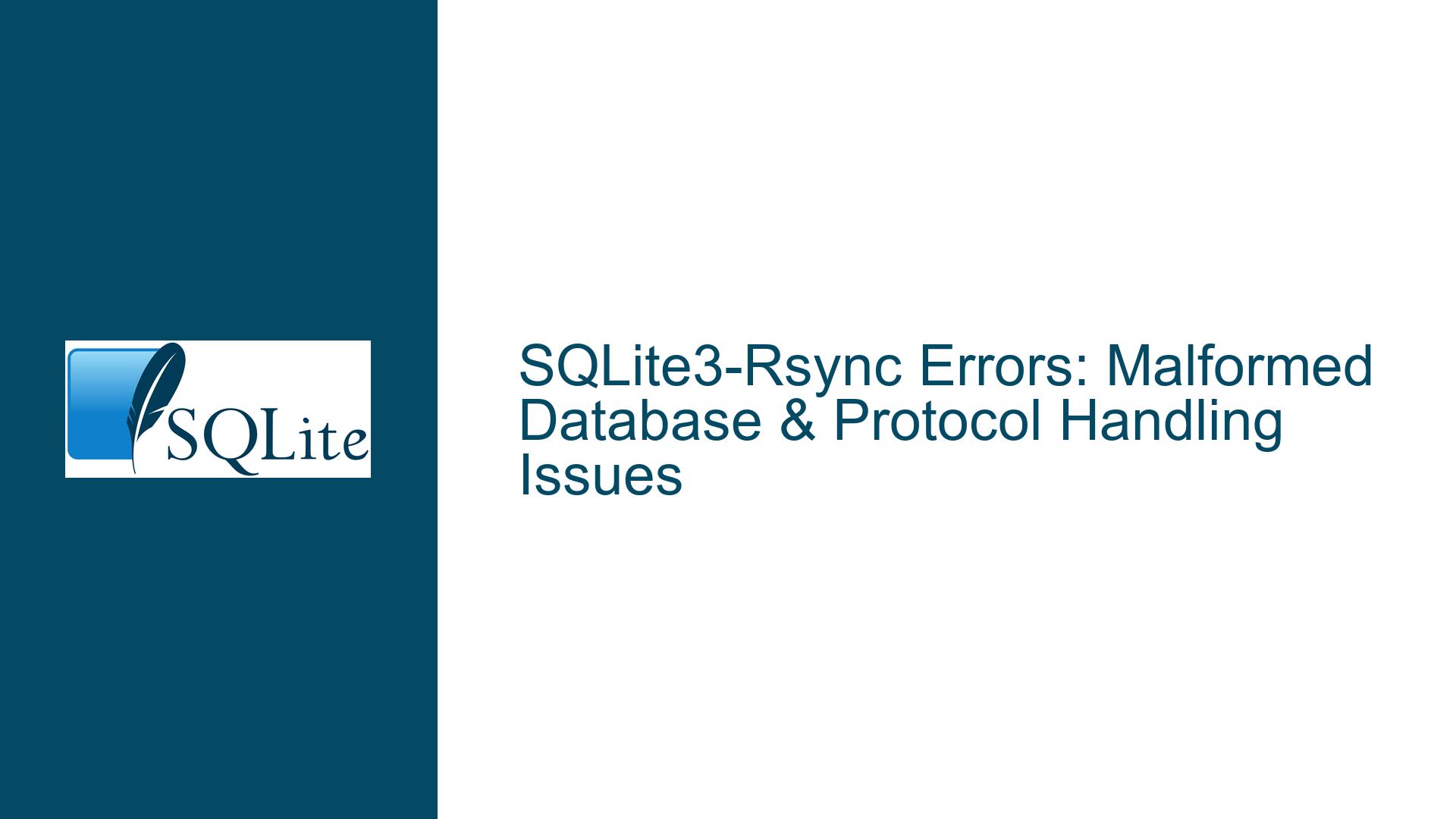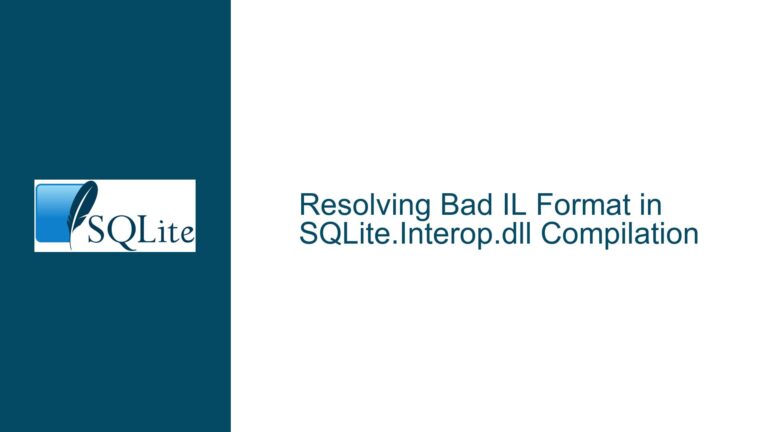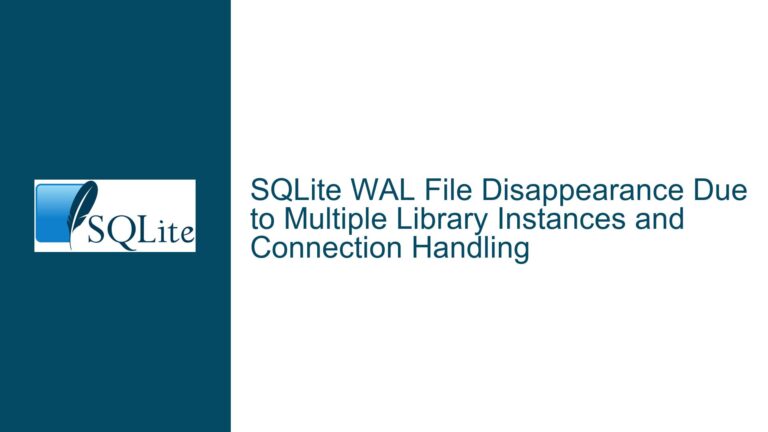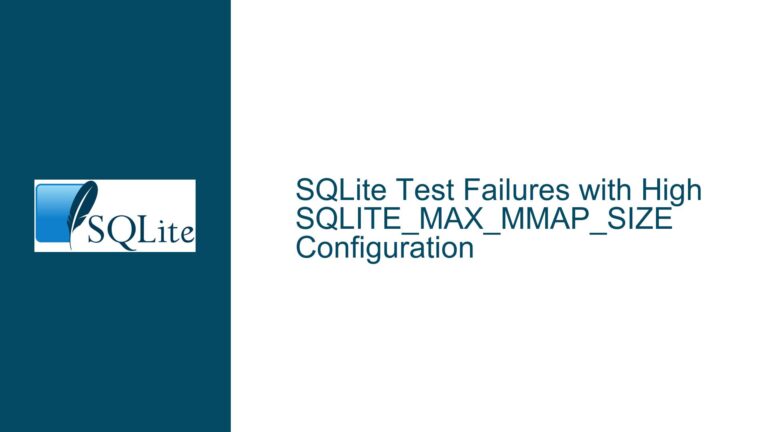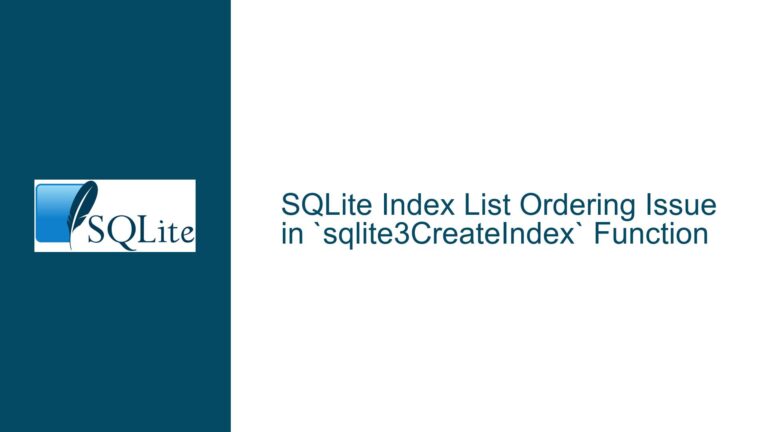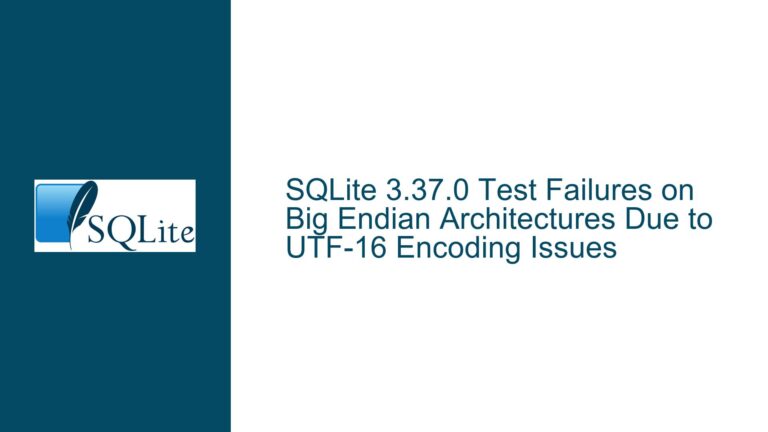SQLite3-Rsync Errors: Malformed Database & Protocol Handling Issues
Protocol Termination Logic and Resource Leakage in SQLite3-Rsync
Issue Overview
The core problem revolves around synchronization failures in the sqlite3-rsync utility when replicating SQLite databases. Users encounter critical errors such as "database disk image is malformed" and incomplete synchronization due to protocol mishandling, premature termination of communication loops, and unclosed system resources. The utility fails to ensure proper handshake completion between the origin and replica databases, leading to truncated error reporting and inconsistent database states.
A minimal reproduction involves creating two databases (origin.sqlite and replica.sqlite) with mismatched schemas (e.g., differing table structures) and attempting synchronization via sqlite3-rsync. The origin database terminates its communication loop immediately after sending ORIGIN_END, bypassing the critical REPLICA_END acknowledgment from the replica. This early exit prevents error messages from propagating correctly, leaving users with incomplete diagnostics. Additionally, the utility leaks pIn and pOut pipe handles due to missing pclose2 calls, risking resource exhaustion in long-running operations.
The malformed database error arises when the replica attempts to apply SQL statements (e.g., INSERT INTO sqlite_dbpage) that conflict with schema differences or file header metadata inconsistencies. These include mismatches in the change counter (offsets 24 and 92) and SQLite library version (offset 96) between origin and replica databases. A typographical error in the error message ("Databases where not synced") further confuses users, though it does not affect runtime behavior.
Root Causes of Synchronization Failures
Premature Protocol Termination:
The origin process exits its main loop immediately after transmittingORIGIN_END, without waiting for the replica’sREPLICA_ENDsignal. This violates the protocol’s state machine, which requires bidirectional acknowledgment before termination. Consequently, errors occurring on the replica side afterORIGIN_ENDare never reported to the origin, leaving synchronization attempts incomplete.Resource Leakage via Unclosed Pipes:
ThepInandpOutfile streams (representing pipes to the replica process) are initialized but never closed viapclose2due to an early exit in the main loop. This leaks system resources and may destabilize the host environment during repeated synchronization attempts.Schema and Metadata Incompatibilities:
- Schema Mismatches: Tables or indexes present in the replica but absent in the origin (e.g.,
replica.twoandreplica.threein the minimal example) trigger malformed database errors during page-level synchronization. Thesqlite_dbpagevirtual table operations assume schema parity, which is not enforced before replication. - File Header Metadata Drift: The replica’s file header increments its change counter independently, and its SQLite version may differ from the origin’s. These discrepancies are unavoidable but can cause validation failures if not explicitly handled.
- Schema Mismatches: Tables or indexes present in the replica but absent in the origin (e.g.,
Incorrect Host/Path Parsing Logic:
The utility mishandleshost:pathnotations by not requiring the:delimiter to precede the first/. For example,./origin:sqliteis parsed as a remote host instead of a local path, leading to file access errors. This diverges from standardrsyncbehavior, causing confusion during local file operations.Diagnostic Message Corruption:
Lost error messages stem from the origin process terminating before receiving replica-side failures. The typo "where" instead of "were" in the final error output further degrades user trust in the tool’s reliability.
Resolving Protocol Flaws and Database Corruption
Step 1: Update to the Patched SQLite Version
Solution:
Apply the fix from SQLite check-in 39c56c836a8ae52c or later. This revision corrects the protocol termination logic by ensuring the origin process remains active until REPLICA_END is received.
Verification:
After updating, rerun the minimal test case:
sqlite3-rsync origin.sqlite replica.sqlite
The output should no longer display the "database disk image is malformed" error if schema mismatches are resolved. Confirm that the final message states "Databases were synced successfully" (note the corrected "were").
Step 2: Enforce Protocol Handshake Completion
Code Fix:
Modify the origin’s main loop to continue listening for REPLICA_END after sending ORIGIN_END. Example pseudocode:
while (1) {
char *msg = read_message(pIn);
if (msg == REPLICA_END) break;
if (msg == ERROR) handle_error();
}
pclose2(pIn);
pclose2(pOut);
Rationale:
This ensures all replica-side errors are captured before termination. The pclose2 calls now execute unconditionally, preventing resource leaks.
Step 3: Align Schema and Metadata Pre-Synchronization
Preflight Checks:
Before initiating synchronization, validate that:
- Both databases have identical schemas (tables, indexes, triggers).
- Both use the same
journal_mode(e.g.,WAL). - The replica’s SQLite version is equal to or newer than the origin’s.
Automating Schema Checks:
Extend sqlite3-rsync to compare schemas using:
SELECT sql FROM origin.sqlite_schema EXCEPT SELECT sql FROM replica.sqlite_schema;
If non-empty results, abort synchronization and report discrepancies.
Handling Metadata Differences:
Document that the replica’s change counter and SQLite version will differ post-synchronization. These are benign and expected. To suppress validation warnings, override the replica’s header fields using direct file writes (caution: requires PRAGMA writable_schema=ON).
Step 4: Correct Host/Path Parsing Logic
Code Adjustment:
Update the argument parser to split host:path only if the : precedes the first /. For example, ./origin:sqlite should parse as a local path ./origin:sqlite, not a remote host. Use rsync-compatible parsing libraries to avoid reinventing edge cases.
Testing:
Validate paths with mixed colons and slashes:
sqlite3-rsync user@host:/path/origin.sqlite ./replica.sqlite # Correctly parses remote host
sqlite3-rsync ./origin:sqlite ./replica:sqlite # Treats as local files
Step 5: Mitigate Malformed Database Errors
Cause Analysis:
The sqlite_dbpage virtual table writes fail when the replica’s schema cannot accommodate page-level changes. This occurs if tables/indexes differ in structure or storage parameters.
Workarounds:
- Full Schema Reset: Delete the replica database and reinitialize it from the origin.
- Incremental Schema Alignment: Manually apply
ALTER TABLEorCREATE INDEXstatements to the replica before synchronization. - Use
--safeMode: Extendsqlite3-rsyncto disablesqlite_dbpageand use SQL statement replication instead (slower but schema-tolerant).
Step 6: Address Error Message Typos and Clarity
Code Change:
Correct the typo in src/rsync.c (search for "Databases where not synced" and replace "where" with "were").
Enhanced Diagnostics:
Log all replica-side errors to a file or stderr before termination. Include timestamps and error codes to aid debugging.
Step 7: Document Unavoidable Differences
User Guidance:
Explicitly state in the sqlite3-rsync manual that the following replica attributes will always diverge:
- Change Counter: Incremented on every write, used for conflict detection.
- SQLite Version: Reflects the library used during the last sync.
Rationale:
These differences do not affect data integrity but may trigger third-party validation tools. Provide scripts to reset the change counter if required for compliance.
Step 8: Regression Testing and Continuous Validation
Test Suite Additions:
- Protocol Handshake Completion: Verify that
ORIGIN_ENDandREPLICA_ENDare exchanged. - Resource Leak Checks: Use Valgrind or ASAN to confirm
pclose2closes all pipes. - Schema Mismatch Simulations: Intentionally create table discrepancies and validate error reporting.
Automation:
Integrate these tests into SQLite’s CI/CD pipeline to prevent future regressions.
By methodically addressing protocol flaws, enforcing schema parity, and improving diagnostics, users can achieve reliable database synchronization with sqlite3-rsync. Persistent metadata differences should be acknowledged as inherent to the replication process rather than treated as errors.
